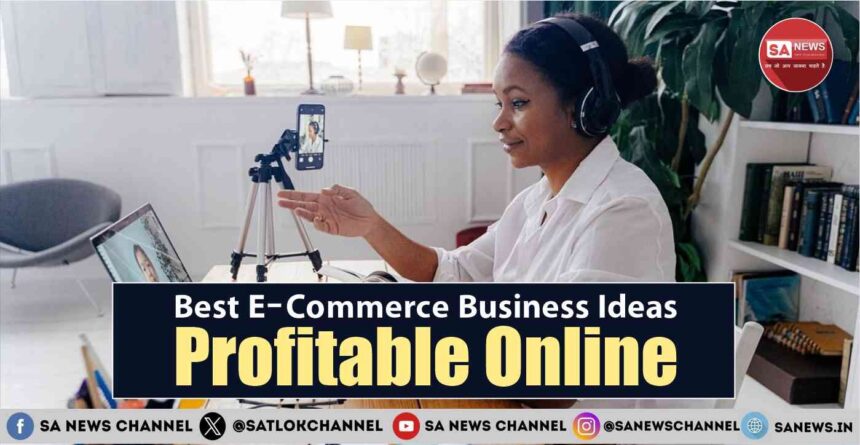The e-commerce landscape is experiencing unprecedented growth, with global online sales projected to reach $8.1 trillion by 2026. As artificial intelligence reshapes consumer behavior and sustainability becomes non-negotiable, 2025 presents unique opportunities for entrepreneurs to launch profitable online businesses.
Whether you’re looking to escape the 9-to-5 grind or scale an existing venture, the digital marketplace offers accessible entry points with relatively low startup costs. From AI-powered personalization tools to eco-friendly product lines, today’s most successful ecommerce business ideas leverage emerging technologies while solving real customer problems.
1. AI-Powered Personalized Products
What It Is
Creating customized products using artificial intelligence to analyze customer preferences, body measurements, or usage patterns. This includes personalized skincare formulations, custom-fit clothing, or tailored nutrition supplements.

Why It’s Relevant in 2025
- AI accessibility: Tools like GPT-4 and Claude make AI integration affordable for small businesses
- Consumer demand: 80% of consumers prefer brands that offer personalized experiences
- Data availability: Advanced analytics provide deeper customer insights than ever before
Target Customers
- Health-conscious millennials and Gen Z (ages 25-40)
- Busy professionals seeking convenience
- Consumers with specific dietary restrictions or skin conditions
Monetization Strategy
- Subscription model: Monthly personalized product deliveries ($30-150/month)
- Premium customization: Higher margins on tailored products (40-60% vs. 20-30% for standard items)
- Data insights: Selling anonymized consumer trend data to manufacturers
Startup Needs
- Initial investment: $15,000-50,000
- Skills required: Basic AI understanding, product development, digital marketing
- Platforms: Shopify Plus, custom development, AI APIs (OpenAI, Anthropic)
- Tools: Customer data platforms, 3D modeling software, inventory management systems
Pros and Cons
Pros:
- Higher customer lifetime value
- Reduced return rates through better fit
- Premium pricing justification
- Strong customer loyalty
Cons:
- Complex supply chain management
- Higher initial development costs
- Privacy concerns and regulations
- Longer customer acquisition cycle
Real-World Example
Function of Beauty generated over $100 million in revenue by offering personalized hair care products based on customer questionnaires and AI analysis.
2. Sustainable and Eco-Friendly Products
What It Is
Selling environmentally conscious products including biodegradable packaging, upcycled materials, zero-waste lifestyle items, and carbon-neutral shipping options.

Why It’s Relevant in 2025
- Consumer shift: 73% of global consumers willing to pay more for sustainable products
- Regulatory pressure: Increased government regulations on plastic waste and carbon emissions
- Supply chain transparency: Blockchain technology enables verified sustainability claims
Target Customers
- Environmentally conscious consumers (ages 25-45)
- Urban professionals with disposable income
- Parents concerned about their children’s future
Monetization Strategy
- Premium pricing: 20-40% higher margins on eco-friendly alternatives
- Subscription boxes: Monthly sustainable product discoveries
- B2B sales: Bulk sales to environmentally conscious businesses
- Carbon offset programs: Additional revenue stream from offset sales
Startup Needs
- Initial investment: $10,000-30,000
- Skills required: Supply chain management, sustainability knowledge, content marketing
- Platforms: Shopify, WooCommerce, Etsy (for handmade items)
- Certifications: B-Corp, Fair Trade, organic certifications
Pros and Cons
Pros:
- Growing market demand
- Premium pricing opportunities
- Strong brand loyalty
- Positive social impact
Cons:
- Higher sourcing costs
- Complex supply chain verification
- Greenwashing accusations risk
- Limited supplier options
Real-World Example
Grove Collaborative reached $400 million in annual revenue by focusing exclusively on sustainable household products and eco-friendly packaging.
3. Health and Wellness Supplements
What It Is
Selling targeted nutritional supplements, adaptogens, and wellness products designed for specific health goals like immune support, stress reduction, or cognitive enhancement.
Why It’s Relevant in 2025
- Market growth: Global supplement market expected to reach $272 billion by 2028
- Post-pandemic focus: Increased awareness of preventive health measures
- Personalization trend: AI-driven supplement recommendations based on health data
Target Customers
- Health-conscious adults (ages 30-55)
- Fitness enthusiasts and athletes
- Individuals with chronic health conditions
- Busy professionals managing stress
Monetization Strategy
- Subscription model: Monthly supplement deliveries ($40-120/month)
- Bundles and kits: Themed product combinations for specific health goals
- Consultation services: Paid health consultations with nutritionists
- Private labeling: White-label products for other health brands
Startup Needs
- Initial investment: $25,000-75,000
- Skills required: Regulatory compliance, health marketing, customer service
- Platforms: Shopify, BigCommerce, direct-to-consumer sites
- Compliance: FDA regulations, third-party testing, GMP certification
Pros and Cons
Pros:
- High profit margins (50-70%)
- Recurring revenue potential
- Growing market demand
- Multiple monetization streams
Cons:
- Heavy regulatory requirements
- Customer acquisition costs
- Quality control challenges
- Medical liability concerns
Real-World Example
Athletic Greens built a $100+ million business by focusing on one premium product with aggressive subscription marketing and influencer partnerships.
4. Pet Products and Accessories
What It Is
Specialized products for pet owners including premium pet food, smart pet devices, custom pet accessories, and health monitoring tools.
Why It’s Relevant in 2025
- Pet industry growth: $261 billion global market with 8% annual growth
- Humanization trend: Pets treated as family members with premium spending
- Tech integration: Smart collars, health monitors, and automated feeding systems
Target Customers
- Pet owners with higher disposable income
- Tech-savvy millennials and Gen X
- Elderly pet owners seeking convenience
- Pet parents with special needs animals
Monetization Strategy
- Subscription boxes: Monthly pet product deliveries ($25-60/month)
- Premium products: High-quality, organic, or specialized items
- Custom services: Personalized pet accessories and portraits
- Insurance partnerships: Affiliate commissions from pet insurance
Startup Needs
- Initial investment: $15,000-40,000
- Skills required: Pet industry knowledge, e-commerce, social media marketing
- Platforms: Shopify, Amazon FBA, Chewy marketplace
- Suppliers: Pet product manufacturers, private label companies
Pros and Cons
Pros:
- Loyal customer base
- Emotional purchasing decisions
- Multiple product categories
- Growing market size
Cons:
- Seasonal demand fluctuations
- Quality and safety concerns
- Competitive marketplace
- Inventory management complexity
Real-World Example
BarkBox generated over $500 million in annual revenue through monthly subscription boxes filled with curated pet products and toys.
5. Digital Products and Online Courses
What It Is
Creating and selling educational content, software tools, templates, and digital resources that solve specific problems for target audiences.
Why It’s Relevant in 2025
- Remote learning: Permanent shift toward online education and skill development
- Creator economy: $104 billion market for digital content creators
- Low barriers: Minimal startup costs and scalable delivery
Target Customers
- Professionals seeking skill development
- Entrepreneurs and small business owners
- Students and career changers
- Hobbyists and creative individuals
Monetization Strategy
- Course sales: One-time purchases ($99-2,000 per course)
- Membership sites: Monthly recurring revenue ($29-199/month)
- Coaching programs: High-value personalized services ($500-5,000)
- Affiliate marketing: Promoting complementary products and tools
Startup Needs
- Initial investment: $2,000-10,000
- Skills required: Subject matter expertise, content creation, marketing
- Platforms: Teachable, Thinkific, Kajabi, Gumroad
- Tools: Video editing software, course creation tools, email marketing
Pros and Cons
Pros:
- High profit margins (80-95%)
- Scalable with no inventory
- Location independence
- Multiple revenue streams
Cons:
- Content creation time investment
- Market saturation in popular niches
- Ongoing content updates required
- Customer support demands
Real-World Example
MasterClass reached over $100 million in annual revenue by offering celebrity-taught online courses with high production value and strategic marketing.
■ Also Read: 10 Proven Startup Success Tips Every Founder Should Know
6. Smart Home and IoT Devices
What It Is
Selling connected devices that integrate with home automation systems, including smart lighting, security systems, energy monitors, and voice-controlled appliances.

Why It’s Relevant in 2025
- Market expansion: Smart home market projected to reach $537 billion by 2030
- Technology maturity: More reliable and affordable IoT components
- Energy efficiency: Growing focus on reducing household energy consumption
Target Customers
- Tech-savvy homeowners (ages 25-50)
- Energy-conscious consumers
- Security-focused families
- Early adopters of new technology
Monetization Strategy
- Product sales: Direct hardware sales with 30-50% margins
- Subscription services: Monthly monitoring and premium features
- Installation services: Professional setup and configuration
- Data insights: Anonymized usage data for utility companies
Startup Needs
- Initial investment: $50,000-150,000
- Skills required: Hardware knowledge, software development, supply chain
- Platforms: Amazon, own e-commerce site, retail partnerships
- Certifications: FCC approval, safety certifications, compatibility testing
Pros and Cons
Pros:
- High-growth market
- Recurring revenue potential
- Premium pricing opportunities
- Technology differentiation
Cons:
- High development costs
- Complex technical requirements
- Inventory investment
- Rapid technology obsolescence
Real-World Example
Ring was acquired by Amazon for $1.2 billion after building a successful smart doorbell business through direct-to-consumer sales and strategic partnerships.
7. Niche Fashion and Accessories
What It Is
Targeting specific fashion segments like plus-size clothing, modest fashion, adaptive clothing for disabilities, or cultural-specific apparel.
Why It’s Relevant in 2025
- Inclusivity demand: Consumers seeking representation in fashion
- Underserved markets: Traditional retailers often ignore niche segments
- Direct-to-consumer: Easier to reach specific communities online
Target Customers
- Underrepresented groups in traditional fashion
- Consumers with specific cultural or religious requirements
- People with disabilities or special needs
- Fashion-conscious individuals in overlooked demographics
Monetization Strategy
- Direct sales: Higher margins than wholesale (50-70%)
- Custom orders: Premium pricing for made-to-order items
- Subscription styling: Monthly outfit selections
- Community building: Paid membership for exclusive access
Startup Needs
- Initial investment: $20,000-60,000
- Skills required: Fashion design, community building, social media marketing
- Platforms: Shopify, Etsy, social media commerce
- Suppliers: Ethical manufacturers, sustainable fabric sources
Pros and Cons
Pros:
- Loyal customer communities
- Less competition in niches
- Higher emotional connection
- Premium pricing potential
Cons:
- Smaller addressable market
- Inventory management challenges
- Size and fit complications
- Cultural sensitivity requirements
Real-World Example
Fenty by Rihanna disrupted the beauty industry by focusing on inclusive shade ranges, generating $570 million in revenue within its first year.
8. Meal Kits and Specialty Foods
What It Is
Curated meal kits, specialty dietary foods, artisanal products, and cooking ingredients delivered to customers’ doors.
Why It’s Relevant in 2025
- Convenience culture: Busy consumers seeking time-saving solutions
- Dietary restrictions: Growing awareness of food allergies and health conditions
- Experience economy: Cooking as entertainment and skill-building
Target Customers
- Busy professionals and families
- Health-conscious consumers
- Cooking enthusiasts
- People with dietary restrictions
Monetization Strategy
- Subscription model: Weekly meal kit deliveries ($60-150/week)
- One-time purchases: Specialty ingredients and products
- Recipe content: Premium cooking instruction and tips
- Corporate partnerships: Meal kits for office events and team building
Startup Needs
- Initial investment: $30,000-100,000
- Skills required: Food safety, supply chain, logistics
- Platforms: Custom subscription platform, third-party logistics
- Certifications: Food safety, organic certifications, allergen management
Pros and Cons
Pros:
- Recurring revenue model
- High customer lifetime value
- Growing market demand
- Emotional customer connection
Cons:
- Complex logistics and fulfillment
- Perishable inventory challenges
- High customer acquisition costs
- Seasonal demand variations
Real-World Example
HelloFresh reached over $7 billion in annual revenue by perfecting the meal kit subscription model with efficient logistics and targeted marketing.
9. Beauty and Personal Care
What It Is
Innovative beauty products including clean beauty, men’s grooming, K-beauty, and personalized skincare solutions.
Why It’s Relevant in 2025
- Clean beauty movement: Consumers avoiding harmful chemicals
- Male grooming growth: Men’s personal care market expanding rapidly
- Personalization: AI-driven product recommendations based on skin analysis
Target Customers
- Beauty enthusiasts and influencers
- Health-conscious consumers
- Men entering the grooming market
- Consumers with specific skin conditions
Monetization Strategy
- Subscription boxes: Monthly beauty product discoveries
- Premium products: High-margin specialty items
- Consultation services: Personalized beauty advice
- Influencer partnerships: Collaborative product lines
Startup Needs
- Initial investment: $25,000-75,000
- Skills required: Beauty industry knowledge, social media marketing, compliance
- Platforms: Shopify, Sephora marketplace, social commerce
- Regulations: FDA compliance, ingredient safety, labeling requirements
Pros and Cons
Pros:
- High profit margins
- Strong social media presence
- Loyal customer base
- Multiple product lines
Cons:
- Highly competitive market
- Regulatory requirements
- Seasonal trends
- Influencer dependency
Real-World Example
Glossier built a $1.2 billion valuation by focusing on minimal, Instagram-friendly beauty products with strong community engagement.
10. Home Fitness and Wellness Equipment

What It Is
Compact fitness equipment, wellness devices, recovery tools, and home gym accessories designed for small spaces and busy lifestyles.
Why It’s Relevant in 2025
- Home fitness trend: Permanent shift toward home-based workouts
- Space efficiency: Urban living requires compact solutions
- Wellness focus: Mental health and physical recovery prioritized
Target Customers
- Urban professionals with limited space
- Busy parents seeking convenient workouts
- Seniors focusing on mobility and wellness
- Fitness enthusiasts building home gyms
Monetization Strategy
- Product sales: Equipment and accessories
- Subscription services: Workout content and coaching
- Replacement parts: Ongoing revenue from consumables
- Corporate wellness: Bulk sales to companies
Startup Needs
- Initial investment: $20,000-80,000
- Skills required: Fitness knowledge, product design, digital marketing
- Platforms: Amazon FBA, Shopify, retail partnerships
- Suppliers: Manufacturing partners, quality control systems
Pros and Cons
Pros:
- Growing market demand
- Recurring revenue potential
- High customer engagement
- Multiple monetization streams
Cons:
- Seasonal demand fluctuations
- Product liability concerns
- Inventory investment
- Competition from established brands
Real-World Example
Peloton revolutionized home fitness by combining equipment sales with subscription content, reaching over $4 billion in annual revenue.
11. Baby and Children’s Products
What It Is
Innovative products for infants and children including smart baby monitors, educational toys, organic baby food, and developmental tools.
Why It’s Relevant in 2025
- Parental investment: Parents willing to spend premium for child development
- Safety concerns: Increased awareness of product safety and materials
- Educational focus: Early childhood development prioritized
Target Customers
- New parents and expecting families
- Grandparents and gift-buyers
- Daycare centers and educational facilities
- Parents of children with special needs
Monetization Strategy
- Subscription boxes: Monthly educational toys and products
- Premium products: High-quality, safe, and educational items
- Consulting services: Parenting advice and child development
- Bulk sales: Products for educational institutions
Startup Needs
- Initial investment: $15,000-50,000
- Skills required: Child development knowledge, safety regulations, marketing
- Platforms: Amazon, Shopify, specialty retailers
- Certifications: Safety standards, organic certifications, educational endorsements
Pros and Cons
Pros:
- Emotional purchasing decisions
- Premium pricing acceptance
- Word-of-mouth marketing
- Recurring customer needs
Cons:
- Strict safety regulations
- Age-limited product usage
- Seasonal demand patterns
- High customer acquisition costs
Real-World Example
Lovevery built a successful business by creating developmentally appropriate toys delivered through subscription boxes, focusing on child development milestones.
12. Automotive Accessories and Parts
What It Is
Aftermarket car parts, accessories, and maintenance products including electric vehicle charging accessories, car care products, and custom modifications.

Why It’s Relevant in 2025
- EV adoption: Growing need for charging accessories and EV-specific products
- DIY maintenance: Consumers maintaining vehicles longer due to economic factors
- Customization culture: Personalization and modification trends
Target Customers
- Car enthusiasts and hobbyists
- Electric vehicle owners
- DIY mechanics and maintenance-focused consumers
- Commercial fleet operators
Monetization Strategy
- Direct sales: Parts and accessories with 40-60% margins
- Installation services: Professional installation and customization
- Subscription maintenance: Regular maintenance product deliveries
- B2B sales: Bulk sales to mechanics and dealerships
Startup Needs
- Initial investment: $30,000-100,000
- Skills required: Automotive knowledge, e-commerce, supplier relationships
- Platforms: eBay Motors, Amazon, specialized automotive marketplaces
- Inventory: Warehouse space, inventory management systems
Pros and Cons
Pros:
- Large addressable market
- Recurring customer purchases
- High-margin specialty items
- Growing EV market
Cons:
- Complex product catalog
- Seasonal demand variations
- Returns and compatibility issues
- Inventory investment requirements
Real-World Example
AutoZone generates over $15 billion annually by focusing on automotive aftermarket parts with strong e-commerce integration and local store pickup options.
13. Artisanal and Handmade Products
What It Is
Unique, handcrafted items including artisanal food products, handmade jewelry, custom furniture, and personalized gifts.
Why It’s Relevant in 2025
- Authenticity demand: Consumers seeking unique, non-mass-produced items
- Local support: Increased interest in supporting small businesses and artisans
- Gifting culture: Personalized gifts preferred over generic options
Target Customers
- Consumers seeking unique, high-quality items
- Gift-buyers looking for personalized options
- Supporters of small businesses and artisans
- Collectors and enthusiasts
Monetization Strategy
- Direct sales: Premium pricing for handmade items
- Custom orders: Higher margins for personalized products
- Workshops: Teaching skills and techniques
- Wholesale: Selling to boutiques and specialty stores
Startup Needs
- Initial investment: $5,000-25,000
- Skills required: Crafting expertise, photography, online marketing
- Platforms: Etsy, Amazon Handmade, own e-commerce site
- Tools: Crafting supplies, photography equipment, packaging materials
Pros and Cons
Pros:
- High profit margins
- Strong customer loyalty
- Creative fulfillment
- Flexible scaling
Cons:
- Time-intensive production
- Limited scalability
- Quality consistency challenges
- Seasonal demand fluctuations
Real-World Example
Etsy’s top sellers generate millions in revenue by focusing on unique, handmade products with strong brand stories and customer engagement.
14. Educational Toys and STEM Products
What It Is
Learning-focused toys, STEM kits, educational games, and developmental tools designed to teach specific skills or concepts.

Why It’s Relevant in 2025
- Educational focus: Parents prioritizing child development and learning
- STEM emphasis: Increased focus on science, technology, engineering, and math education
- Screen time concerns: Seeking alternatives to digital entertainment
Target Customers
- Parents focused on child development
- Educators and homeschooling families
- Grandparents and gift-buyers
- After-school programs and educational centers
Monetization Strategy
- Subscription boxes: Monthly educational activities and projects
- Product sales: Individual toys and kits
- Curriculum licensing: Educational content for schools
- Corporate partnerships: Products for educational institutions
Startup Needs
- Initial investment: $20,000-60,000
- Skills required: Educational background, child development, safety regulations
- Platforms: Amazon, educational retailers, direct-to-consumer
- Certifications: Safety standards, educational endorsements, age-appropriate testing
Pros and Cons
Pros:
- Premium pricing acceptance
- Strong parental investment
- Educational impact
- Growing market demand
Cons:
- Strict safety regulations
- Seasonal purchasing patterns
- Age-limited product usage
- Educational effectiveness pressure
Real-World Example
KiwiCo built a successful subscription business by delivering monthly STEM projects that combine education with hands-on learning experiences.
15. Travel and Adventure Gear
What It Is
Specialized equipment for outdoor activities, travel accessories, camping gear, and adventure sports equipment.
Why It’s Relevant in 2025
- Outdoor recreation growth: Increased interest in outdoor activities post-pandemic
- Travel recovery: Return to travel with focus on experiences over possessions
- Sustainability focus: Durable, eco-friendly outdoor gear demand
Target Customers
- Outdoor enthusiasts and adventurers
- Frequent travelers and digital nomads
- Families seeking outdoor experiences
- Professional guides and outdoor instructors
Monetization Strategy
- Product sales: Equipment and accessories
- Rental services: High-end gear rental for occasional users
- Subscription boxes: Monthly outdoor and travel gear
- Corporate team building: Bulk sales for outdoor corporate events
Startup Needs
- Initial investment: $25,000-80,000
- Skills required: Outdoor knowledge, product testing, digital marketing
- Platforms: Amazon, outdoor specialty retailers, own e-commerce site
- Suppliers: Manufacturing partners, quality control, durability testing
Pros and Cons
Pros:
- Passionate customer base
- Premium pricing for quality
- Seasonal recurring purchases
- Strong community engagement
Cons:
- Seasonal demand fluctuations
- Product durability expectations
- Competition from established brands
- Weather-dependent sales
Real-World Example
REI Co-op generates over $3 billion annually by combining product sales with outdoor experiences and strong community building.
How to Start Your E-Commerce Business in 2025
Step 1: Choose Your Niche and Validate Demand
Research market demand using tools like Google Trends, Amazon Best Sellers, and social media analytics. Start with a focused niche rather than trying to compete with established generalist retailers.
Step 2: Develop Your Business Plan
Create a comprehensive plan including target market analysis, competitive research, pricing strategy, and financial projections. Consider both one-time and recurring revenue models.
Step 3: Set Up Your Online Store
Choose an e-commerce platform that matches your technical skills and business needs. Shopify offers the best balance of features and ease of use for most beginners, while WooCommerce provides more customization for WordPress users.
Step 4: Source Products and Manage Inventory
Decide between manufacturing, private labeling, dropshipping, or retail arbitrage. Each model has different startup costs, profit margins, and operational requirements.
Step 5: Implement Marketing and Customer Acquisition
Focus on organic social media marketing, search engine optimization, and email marketing initially. Paid advertising can accelerate growth once you’ve proven product-market fit.
Step 6: Optimize for Conversion and Growth
Use analytics to understand customer behavior, optimize your website for conversions, and implement systems for customer service and fulfillment.
Frequently Asked Questions
What are the most profitable e-commerce niches in 2025?
The most profitable ecommerce niches combine high demand with underserved markets. AI-powered personalized products, sustainable goods, and health supplements offer the highest profit margins (40-70%), while pet products and baby items provide strong recurring revenue opportunities. The key is finding niches where you can justify premium pricing through unique value propositions.
How much money do I need to start an e-commerce business?
Startup costs vary significantly by business model. Digital products require as little as $2,000-10,000, while physical products typically need $15,000-50,000 for inventory and setup. Dropshipping reduces initial investment to $5,000-15,000, but offers lower profit margins. Factor in platform fees, marketing costs, and 3-6 months of operating expenses.
What is the best platform to start an online store?
Shopify is the most popular choice for beginners, offering comprehensive features, app integrations, and reliable hosting for $29-299/month. WooCommerce provides more customization options for WordPress users but requires technical knowledge. Consider BigCommerce for larger catalogs and Squarespace for design-focused brands.
How long does it take to make money from an e-commerce business?
Most successful e-commerce businesses take 6-18 months to become profitable, depending on the niche, marketing effectiveness, and initial investment. Digital products can generate revenue within 30-90 days, while physical products typically require 3-6 months for inventory, marketing, and customer acquisition. Focus on validating demand and optimizing conversion rates before scaling.
What are the biggest challenges in starting an e-commerce business?
The primary challenges include customer acquisition costs, inventory management, competition from established brands, and maintaining consistent cash flow. Many new entrepreneurs underestimate marketing costs and the time required to build brand awareness. Success requires patience, continuous learning, and adaptability to market changes.
Beyond Profit: Building a Purpose-Driven Life Through E-Commerce and Spiritual Wisdom
While launching an e-commerce business in 2025 can bring financial freedom, the deeper question remains—what are we truly seeking beyond success? Amid the rush for innovation and profit, many feel an inner emptiness that money can’t fill. True fulfillment begins when we align material progress with spiritual purpose.
Just as emerging technologies help solve customer problems, authentic spiritual knowledge helps solve the human condition itself. For those ready to explore life’s deeper meaning, books like “Gyan Ganga” and “Way of Living” by Saint Rampal Ji Maharaj offer profound guidance on real worship, soul-purpose, and living with clarity. In the end, a balanced life is not just profitable—it is peaceful, purposeful, and spiritually awakened.









